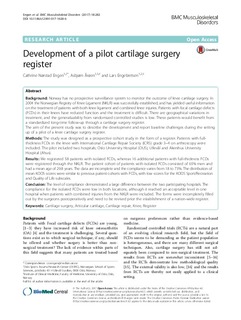| dc.contributor.author | Engen, Cathrine Nørstad | |
| dc.contributor.author | Årøen, Asbjørn | |
| dc.contributor.author | Engebretsen, Lars | |
| dc.date.accessioned | 2018-04-13T11:49:38Z | |
| dc.date.available | 2018-04-13T11:49:38Z | |
| dc.date.created | 2017-09-05T10:50:13Z | |
| dc.date.issued | 2017 | |
| dc.identifier.citation | BMC Musculoskeletal Disorders. 2017, 18, 282. | |
| dc.identifier.issn | 1471-2474 | |
| dc.identifier.uri | http://hdl.handle.net/11250/2494077 | |
| dc.description | This article is distributed under the terms of the Creative Commons Attribution 4.0 International License (http://creativecommons.org/licenses/by/4.0/), which permits unrestricted use, distribution, and reproduction in any medium, provided you give appropriate credit to the original author(s) and the source, provide a link to the Creative Commons license, and indicate if changes were made. The Creative Commons Public Domain Dedication waiver (http://creativecommons.org/publicdomain/zero/1.0/) applies to the data made available in this article, unless otherwise stated. | |
| dc.description.abstract | Background: Norway has no prospective surveillance system to monitor the outcome of knee cartilage surgery. In 2004 the Norwegian Registry of Knee Ligament (NKLR) was successfully established, and has yielded useful information on the treatment of patients with both knee ligament and combined knee injuries. Patients with focal cartilage defects (FCDs) in their knees have reduced function and the treatment is difficult. There are geographical variations in treatment, and the generalizability from randomized controlled studies is low. These patients would benefit from a standardized long-time follow-up through a cartilage surgery register. The aim of the present study was to describe the development and report baseline challenges during the setting up of a pilot of a knee cartilage surgery register. Methods: The study was designed as a prospective cohort study in the form of a register. Patients with fullthickness FCDs in the knee with International Cartilage Repair Society (ICRS) grade 3–4 on arthroscopy were included. The pilot included two hospitals; Oslo University Hospital (OUS), Ullevål and Akershus University Hospital (Ahus). Results: We registered 58 patients with isolated FCDs, whereas 16 additional patients with full-thickness FCDs were registered through the NKLR. The patient cohort of patients with isolated FCDs consisted of 65% men and had a mean age of 29.8 years. The data are incomplete and the compliance varies from 18 to 73%. The distribution of mean KOOS scores were similar to previous patient cohorts with FCDs, with low scores for the KOOS Sport/Recreation and Quality of Life subscales. Conclusion: The level of compliance demonstrated a large difference between the two participating hospitals. The compliance for the isolated FCDs were low in both locations, although it reached an acceptable level in one hospital when patients with combined injuries from the NKLR were included. The forms were incompletely filled out by the surgeons postoperatively and need to be revised prior the establishment of a nation-wide register. | |
| dc.language.iso | eng | |
| dc.subject | cartilage surgery | |
| dc.subject | articular cartilage | |
| dc.subject | cartilage repair | |
| dc.subject | knee | |
| dc.subject | register | |
| dc.title | Development of a pilot cartilage surgery register | |
| dc.type | Peer reviewed | |
| dc.type | Journal article | |
| dc.description.version | publishedVersion | |
| dc.rights.holder | © The Author(s). 2017 | |
| dc.source.volume | 18 | |
| dc.source.journal | BMC Musculoskeletal Disorders | |
| dc.source.issue | 282 | |
| dc.identifier.doi | 10.1186/s12891-017-1638-6 | |
| dc.identifier.cristin | 1491015 | |
| dc.description.localcode | Seksjon for idrettsmedisinske fag / Department of Sports Medicine | |
| cristin.unitcode | 150,0,0,0 | |
| cristin.unitname | Norges idrettshøgskole | |
| cristin.ispublished | true | |
| cristin.fulltext | original | |
| cristin.qualitycode | 1 | |
